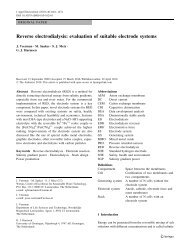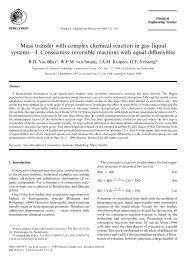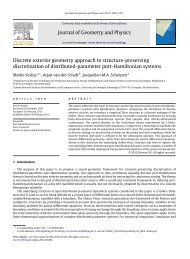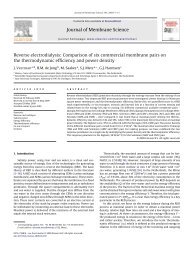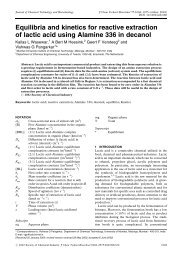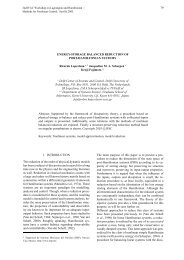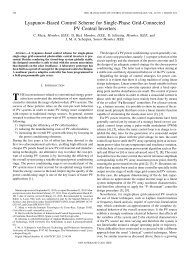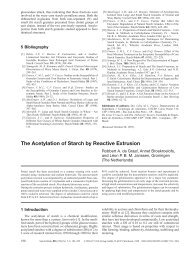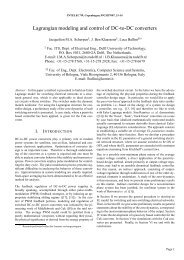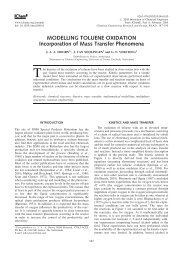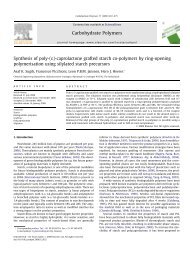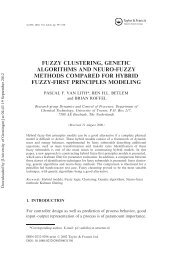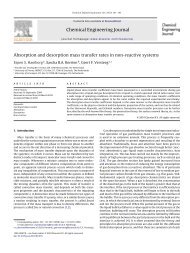The solubilities of phosphate and sulfate salts in supercritical ... - ITM
The solubilities of phosphate and sulfate salts in supercritical ... - ITM
The solubilities of phosphate and sulfate salts in supercritical ... - ITM
Create successful ePaper yourself
Turn your PDF publications into a flip-book with our unique Google optimized e-Paper software.
J. <strong>of</strong> Supercritical Fluids 54 (2010) 1–8<br />
Contents lists available at ScienceDirect<br />
<strong>The</strong> Journal <strong>of</strong> Supercritical Fluids<br />
journal homepage: www.elsevier.com/locate/supflu<br />
<strong>The</strong> <strong>solubilities</strong> <strong>of</strong> <strong>phosphate</strong> <strong>and</strong> <strong>sulfate</strong> <strong>salts</strong> <strong>in</strong> <strong>supercritical</strong> water<br />
Ingo Leusbrock a,∗ , Sybr<strong>and</strong> J. Metz a , Glenn Rexw<strong>in</strong>kel b , Geert F. Versteeg b,c<br />
a Wetsus, Centre <strong>of</strong> Excellence for Susta<strong>in</strong>able Water Technology, Agora 1, 8900 CC Leeuwarden, <strong>The</strong> Netherl<strong>and</strong>s<br />
b PROCEDE TWENTE B.V., 7500 AH Enschede, <strong>The</strong> Netherl<strong>and</strong>s<br />
c University <strong>of</strong> Gron<strong>in</strong>gen, Institute <strong>of</strong> Technology, Eng<strong>in</strong>eer<strong>in</strong>g <strong>and</strong> Management - Centre <strong>of</strong> Natural Sciences <strong>and</strong> Technology, 9747 AG Gron<strong>in</strong>gen, <strong>The</strong> Netherl<strong>and</strong>s<br />
article<br />
<strong>in</strong>fo<br />
abstract<br />
Article history:<br />
Received 19 January 2010<br />
Received <strong>in</strong> revised form 7 March 2010<br />
Accepted 8 March 2010<br />
Keywords:<br />
Phosphates<br />
Solubility<br />
Sulfates<br />
Supercritical water<br />
Inorganic compounds are regularly present <strong>in</strong> aqueous streams. To underst<strong>and</strong> their <strong>in</strong>fluence <strong>and</strong> behavior<br />
on these streams at <strong>supercritical</strong> conditions, little to no property data is available, which can be used<br />
as start<strong>in</strong>g po<strong>in</strong>t for further research or application design. S<strong>in</strong>ce <strong>in</strong>organic compounds tend to precipitate<br />
at these conditions, scal<strong>in</strong>g, block<strong>in</strong>g <strong>and</strong> erosion can occur as a consequence. Furthermore, a separation<br />
<strong>of</strong> (precious) compounds from the bulk stream due to the precipitation is possible. Here, <strong>phosphate</strong> compounds<br />
are regarded as <strong>in</strong>terest<strong>in</strong>g for further <strong>in</strong>vestigation s<strong>in</strong>ce resources are assumed to be depleted<br />
<strong>in</strong> future. As <strong>phosphate</strong> is present <strong>in</strong> many waste streams, these could be used as sources for recoverable<br />
<strong>phosphate</strong>. Result<strong>in</strong>g from these facts <strong>and</strong> options, a proper underst<strong>and</strong><strong>in</strong>g <strong>and</strong> knowledge <strong>of</strong> these systems<br />
is important for later <strong>in</strong>dustrial applications. <strong>The</strong>refore, the authors have <strong>in</strong>vestigated the behavior<br />
<strong>of</strong> <strong>salts</strong> (e.g. NaCl, NaNO 3 <strong>and</strong> MgCl 2 ) <strong>in</strong> <strong>supercritical</strong> water <strong>in</strong> previous works.<br />
To extend this knowledge, the <strong>solubilities</strong> <strong>of</strong> the <strong>sulfate</strong> <strong>salts</strong> MgSO 4 <strong>and</strong> CaSO 4 <strong>in</strong> a range <strong>of</strong><br />
18.8–23.2 MPa <strong>and</strong> 655–675 K as well as <strong>of</strong> the <strong>phosphate</strong> <strong>salts</strong> Na 2 HPO 4 , NaH 2 PO 4 <strong>and</strong> CaHPO 4 <strong>in</strong> a<br />
range <strong>of</strong> 20.5–24.2 MPa <strong>and</strong> 665–690 K were <strong>in</strong>vestigated <strong>in</strong> this work with a cont<strong>in</strong>uous flow method<br />
<strong>in</strong> cont<strong>in</strong>uation <strong>of</strong> former work <strong>of</strong> the authors. <strong>The</strong> <strong>solubilities</strong> were compared with exist<strong>in</strong>g data available<br />
from open literature. A quantitative correlation on base <strong>of</strong> a phase equilibrium between the present<br />
phases was used to describe the behavior <strong>and</strong> to compare it with previous results. For the <strong>in</strong>vestigated<br />
calcium <strong>salts</strong>, CaSO 4 <strong>and</strong> CaHPO 4 , it was found that a significant solubility decrease already happens at<br />
subcritical conditions result<strong>in</strong>g <strong>in</strong> precipitation <strong>in</strong> unwanted locations. For the rema<strong>in</strong><strong>in</strong>g compounds, a<br />
parallel hydrolysis reaction was found as could be seen from a change <strong>in</strong> pH <strong>in</strong> the effluent stream.<br />
© 2010 Elsevier B.V. All rights reserved.<br />
1. Introduction<br />
Supercritical water (SCW) is regarded as one <strong>of</strong> the most promis<strong>in</strong>g<br />
<strong>and</strong> <strong>in</strong>terest<strong>in</strong>g solvents/environments for future <strong>in</strong>dustrial<br />
applications such as hydrothermal conversion <strong>of</strong> biomass [1,2],<br />
destruction <strong>of</strong> waste sludge <strong>and</strong> organic waste compounds [3,4],<br />
particle formation on a micro- <strong>and</strong> nanoscale [5,6], reaction media<br />
for polymerizations <strong>and</strong> conversion processes [7,8] <strong>and</strong> separation<br />
<strong>of</strong> <strong>in</strong>organic compounds. Due to fundamental changes <strong>in</strong> properties<br />
at <strong>supercritical</strong> conditions (critical temperature T c = 647 K, critical<br />
pressure p c = 22.1 MPa), SCW varies to a large degree <strong>in</strong> its<br />
properties compared to the common phases liquid <strong>and</strong> vapor. <strong>The</strong><br />
additional benefit <strong>of</strong> <strong>supercritical</strong> fluids <strong>and</strong> SCW is the fact that<br />
properties like diffusion rate, density <strong>and</strong> viscosity are adjustable <strong>in</strong><br />
the <strong>supercritical</strong> regime [9,10]. As a result <strong>of</strong> the comparably harsh<br />
critical conditions <strong>of</strong> water 1 <strong>and</strong> a limited number <strong>of</strong> <strong>in</strong>dustrial<br />
<strong>and</strong> commercial <strong>in</strong>stallations, available property data on systems<br />
conta<strong>in</strong><strong>in</strong>g <strong>supercritical</strong> water is scarce <strong>in</strong> comparison to other<br />
<strong>supercritical</strong> fluids.<br />
Inorganic compounds can be found <strong>in</strong> a majority <strong>of</strong> aqueous<br />
streams. At <strong>supercritical</strong> conditions, these compounds tend to precipitate<br />
or to form vapor or liquid phases saturated <strong>in</strong> salt. This<br />
precipitation can lead to scal<strong>in</strong>g <strong>and</strong> plugg<strong>in</strong>g <strong>in</strong> <strong>in</strong>stallations <strong>and</strong><br />
therefore has to be controlled or avoided [11,12]. First <strong>in</strong>vestigated<br />
<strong>in</strong> connection with <strong>supercritical</strong> water oxidation (SCWO) [13,14],it<br />
became obvious <strong>in</strong> later applications like <strong>supercritical</strong> water gasification<br />
(SCWG) that the presence <strong>of</strong> <strong>in</strong>organic compounds can have<br />
a major <strong>in</strong>fluence on the reaction <strong>and</strong> the process itself (e.g. as a<br />
catalyst [15]). Furthermore, severe problems can occur for a cont<strong>in</strong>uous<br />
long-term process (e.g. corrosion [16,17], <strong>in</strong>creased pressure<br />
drops due to scal<strong>in</strong>g [12], catalyst poison<strong>in</strong>g [18]). <strong>The</strong>refore, concepts<br />
were developed to avoid the formation <strong>of</strong> such a solid phase<br />
∗ Correspond<strong>in</strong>g author. Tel.: +31 58 2843000; fax: +31 58 2843001.<br />
E-mail address: <strong>in</strong>go.leusbrock@wetsus.nl (I. Leusbrock).<br />
URL: http://www.wetsus.nl (I. Leusbrock).<br />
1 Carbon dioxide as the most frequently applied <strong>supercritical</strong> fluid has a critical<br />
temperature T c = 304 K <strong>and</strong> a critical pressure p c = 7.4 MPa.<br />
0896-8446/$ – see front matter © 2010 Elsevier B.V. All rights reserved.<br />
doi:10.1016/j.supflu.2010.03.003
2 I. Leusbrock et al. / J. <strong>of</strong> Supercritical Fluids 54 (2010) 1–8<br />
Fig. 1. Scheme <strong>of</strong> the experimental setup.<br />
(e.g. different reactor modifications [19,20]) or to separate <strong>in</strong>organic<br />
compounds <strong>in</strong> an <strong>in</strong>tegrated treatment step before the actual<br />
process step [18,21]. For the design <strong>of</strong> these new concepts <strong>and</strong> even<br />
more sophisticated ones like a fractionization <strong>of</strong> different salt fractions,<br />
it is vital to have a sound underst<strong>and</strong><strong>in</strong>g <strong>of</strong> the solubility<br />
<strong>of</strong> these <strong>in</strong>organic compounds <strong>and</strong> their <strong>in</strong>fluence <strong>and</strong> behavior.<br />
One <strong>of</strong> the group <strong>of</strong> compounds, which are <strong>of</strong> <strong>in</strong>terest for a separation<br />
from other compounds, are <strong>phosphate</strong>s. Phosphates are part<br />
<strong>of</strong> many waste streams, which represents a potential source for<br />
recoverable <strong>phosphate</strong> [22]. As <strong>phosphate</strong> resources are limited<br />
<strong>and</strong> a shortage or even a depletion <strong>of</strong> global resources is expected,<br />
new ways have to be found to recover <strong>phosphate</strong> <strong>and</strong> to guarantee<br />
sufficient fertilizers for global food production.<br />
In previous works <strong>of</strong> the authors, monovalent <strong>salts</strong> (alkali<br />
nitrates <strong>and</strong> chlorides [23,24]) <strong>and</strong> bivalent <strong>salts</strong> (calcium <strong>and</strong><br />
magnesium chloride [25]) were <strong>in</strong>vestigated. Here, a cont<strong>in</strong>uous<br />
flow method was used to <strong>in</strong>vestigate the <strong>solubilities</strong> <strong>of</strong> these<br />
compounds. In these studies, different quantitative approaches to<br />
describe <strong>solubilities</strong> <strong>in</strong> SCW were compared. <strong>The</strong> behavior <strong>and</strong> a<br />
quantitative description for the solubility <strong>of</strong> monovalent chloride<br />
<strong>and</strong> nitrate <strong>salts</strong> <strong>and</strong> double-valent chloride <strong>salts</strong> was presented.<br />
In the course <strong>of</strong> this study, the <strong>solubilities</strong> <strong>and</strong> behavior <strong>of</strong> the<br />
bivalent <strong>salts</strong> MgSO 4 <strong>and</strong> CaSO 4 <strong>in</strong> a range <strong>of</strong> 18.8–23.2 MPa <strong>and</strong><br />
655–675 K as well as <strong>of</strong> the mono-/bivalent cation/triple-valent<br />
anion <strong>phosphate</strong> <strong>salts</strong> Na 2 HPO 4 , NaH 2 PO 4 <strong>and</strong> CaHPO 4 <strong>in</strong> a range<br />
<strong>of</strong> 20.5–24.2 MPa <strong>and</strong> 665–690 K was object <strong>of</strong> the <strong>in</strong>vestigations.<br />
<strong>The</strong> experimental data was correlated with an approach derived <strong>in</strong><br />
an earlier work [23]. <strong>The</strong> results <strong>of</strong> this correlation are compared<br />
with previous results <strong>of</strong> the authors as well as with data <strong>of</strong> similar<br />
compounds available <strong>in</strong> literature [26].<br />
2. <strong>The</strong>oretical background<br />
2.1. Correlation <strong>of</strong> the experimental data<br />
For quantitative description <strong>of</strong> the <strong>solubilities</strong>, an approach on<br />
base <strong>of</strong> a phase equilibrium between the present phases is applied<br />
[23,27]. In this approach, the solid phase <strong>and</strong> the <strong>supercritical</strong> fluid<br />
are assumed to form an equilibrium depend<strong>in</strong>g on the conditions <strong>in</strong><br />
the system [23]. <strong>The</strong>reby, a description <strong>of</strong> the equilibrium between<br />
the phases is possible <strong>in</strong> the follow<strong>in</strong>g manner:<br />
a · Me c × m · H 2 O(f ) + b · X d × p · H 2 O(f ) ⇋ Me a X b × n · H 2 O(f )<br />
Me a X b × n · H 2 O(f ) ⇋ Me a X b (s) + n · H 2 O(f )<br />
⇒ K s = ˛Me aX b ×n·H 2 O(f )<br />
·˛MeaX b (s)˛n<br />
H 2 O(f )<br />
Me <strong>and</strong> X resemble the salt cation/the salt anion; a <strong>and</strong> b is the<br />
number <strong>of</strong> ions <strong>in</strong> the salt molecule; c <strong>and</strong> d their valency; s <strong>and</strong><br />
f refer to the solid <strong>and</strong> fluid phase; n, m <strong>and</strong> p to the number <strong>of</strong><br />
water molecules. For this approach it is furthermore assumed that<br />
a formation <strong>of</strong> the solid phase occurs via the associated complex <strong>and</strong><br />
not directly via dissociated ions [28]. For the equilibrium constant<br />
K s , several simplifications can be made. Interaction between the<br />
species <strong>in</strong> the system is neglected; the activity coefficient <strong>of</strong> the<br />
solid phase is assumed as unity. <strong>The</strong> fluid phase is treated as an<br />
ideal one. A more extensive description <strong>of</strong> this approach can be<br />
found be elsewhere [23,24,27]. As a result <strong>of</strong> these assumptions,<br />
the solubility <strong>of</strong> <strong>in</strong>organic compounds <strong>in</strong> <strong>supercritical</strong> water can be<br />
(1)
I. Leusbrock et al. / J. <strong>of</strong> Supercritical Fluids 54 (2010) 1–8 3<br />
described <strong>in</strong> the follow<strong>in</strong>g way:<br />
K ∗ s ≈ m Me aX b ×n·H 2 O(f )<br />
1 · n m,H 2 O(f )<br />
(2)<br />
⇒ m MeaX b ×n·H 2 O(f ) = K ∗ s · n m, H 2 O(f )<br />
Substitut<strong>in</strong>g the equilibrium constant under usage <strong>of</strong> a van’t<br />
H<strong>of</strong>f-like expression leads to the follow<strong>in</strong>g expression:<br />
K ∗ s ≈ m Me aX b ×n·H 2 O(f )<br />
1 · n m, H 2 O(f )<br />
⇒ log m MeaX b ×n·H 2 O<br />
⇒ m MeaX b ×n·H 2 O(f ) = K ∗ s · n m, H 2 O(f )<br />
= log Ks ∗ + n · log m, H 2 O<br />
=− solvH<br />
R · T<br />
+ solvS<br />
+ n · log m, H2 O<br />
R<br />
For a more convenient <strong>in</strong>terpretation <strong>of</strong> the parameters, a<br />
description on an amount <strong>of</strong> substance base is chosen. K s <strong>and</strong> K ∗ s<br />
are the equilibrium constant <strong>and</strong> the equilibrium constant <strong>in</strong>clud<strong>in</strong>g<br />
the simplifications. R is the universal gas constant, T the system<br />
temperature, m the molality, the density, n the coord<strong>in</strong>ation<br />
number. <strong>The</strong> Gibbs energy <strong>of</strong> solvation, solv G, the enthalpy <strong>of</strong> solvation,<br />
solv H, <strong>and</strong> the entropy <strong>of</strong> solvation, solv S are assumed as<br />
<strong>in</strong>dependent <strong>of</strong> the system parameters temperature, pressure <strong>and</strong><br />
density. <strong>The</strong> density <strong>of</strong> pure water is calculated via the IAPWS95<br />
equation <strong>of</strong> state [29]. Experimental data was fitted to the parameters<br />
solv H, solv S <strong>and</strong> n to quantitatively describe the solubility. A<br />
more detailed description on this approach can be found elsewhere<br />
[23,24].<br />
3. Experimental<br />
For the measurements <strong>of</strong> the <strong>solubilities</strong> <strong>of</strong> the <strong>phosphate</strong> <strong>and</strong><br />
<strong>sulfate</strong> <strong>salts</strong>, a cont<strong>in</strong>uous flow method was applied like <strong>in</strong> the<br />
previous works <strong>of</strong> the authors. <strong>The</strong> most important details <strong>of</strong> the<br />
method <strong>and</strong> setup are presented <strong>in</strong> the follow<strong>in</strong>g; a more detailed<br />
description can be found elsewhere [23,24].<br />
<strong>The</strong> setup is designed for an operation up to 25 MPa <strong>and</strong> 723 K.<br />
A scheme <strong>of</strong> the setup can be found <strong>in</strong> Fig. 1. Heat was provided by<br />
a custom-made oven <strong>and</strong> a pre-heater; for pressurization <strong>and</strong> flow,<br />
a HPLC Pump was used (LabAlliance Series III, LabAlliance, USA). An<br />
U-tube was <strong>in</strong>stalled <strong>in</strong>side the oven with a length <strong>of</strong> 265 mm, an<br />
<strong>in</strong>ner diameter <strong>of</strong> 4.6 mm <strong>and</strong> an outer diameter <strong>of</strong> 6.35 mm. <strong>The</strong><br />
temperature <strong>in</strong>side the oven was measured at <strong>in</strong>let, middle <strong>and</strong> outlet<br />
position by st<strong>and</strong>ard Type K thermocouples (relative uncerta<strong>in</strong>ty<br />
0.25%). <strong>The</strong> pressure <strong>in</strong>side the setup is measured with a pressure<br />
sensor (Keller PA23H, relative uncerta<strong>in</strong>ty 0.2%). <strong>The</strong> material <strong>of</strong><br />
choice for all heated parts was Hastelloy, the diameter <strong>of</strong> every<br />
tub<strong>in</strong>g was 1/16 ′′ (= 1.588 mm) if not mentioned otherwise.<br />
<strong>The</strong> feed stream enters the U-tube, where an oversaturation<br />
<strong>of</strong> the feed stream depend<strong>in</strong>g on the system conditions (pressure,<br />
temperature, <strong>and</strong> density) <strong>and</strong> the feed concentration can<br />
occur. If so, the exceed<strong>in</strong>g amount starts to precipitate <strong>and</strong> form<br />
an additional phase till an equilibrium <strong>in</strong> the system has established.<br />
<strong>The</strong> stream exits the U-tube at an equilibrium state with<br />
a composition result<strong>in</strong>g from the system conditions. After cool<strong>in</strong>g<br />
<strong>and</strong> depressurization, samples can be taken. <strong>The</strong> analysis <strong>of</strong><br />
these samples is done via an <strong>in</strong>ductive coupled plasma atom emission<br />
spectrometer (ICP, Perk<strong>in</strong>Elmer Optima 5300DV, Perk<strong>in</strong>Elmer,<br />
USA, uncerta<strong>in</strong>ty < 2% for all <strong>in</strong>vestigated species) for the concentrations<br />
<strong>of</strong> Na, Ca, Mg <strong>and</strong> P. Ionic chromatography (IC, Metrohm<br />
741 Compact IC, Metrohm AG, Switzerl<strong>and</strong>, uncerta<strong>in</strong>ty < 5%<br />
for all <strong>in</strong>vestigated species) was used for measurement <strong>of</strong> the<br />
SO 4 <strong>and</strong> PO 4 concentration. Conductivity measurement <strong>of</strong> the<br />
outlet stream was used for the verification <strong>of</strong> an equilibrium<br />
state <strong>in</strong> the column. pH measurements <strong>of</strong> the samples were performed<br />
us<strong>in</strong>g an st<strong>and</strong>ard pH electrode (WTW pH/Cond 340i/SET,<br />
(3)<br />
Fig. 2. Relative fraction <strong>of</strong> <strong>phosphate</strong> species as a function <strong>of</strong> pH.<br />
WTW Wissenschaftlich-Technische Werkstätten GmbH, Germany,<br />
uncerta<strong>in</strong>ty after calibration ±0.01). <strong>The</strong> outlet temperature (TI-4<br />
<strong>in</strong> Fig. 1) <strong>and</strong> the pressure at the pressure sensor (PI-1 <strong>in</strong> Fig. 1)<br />
were used for the calculation <strong>of</strong> the density <strong>in</strong> the system. <strong>The</strong> feed<br />
solution was prepared with deionized water <strong>and</strong> analytical grade<br />
compounds (Boom B.V., <strong>The</strong> Netherl<strong>and</strong>s).<br />
4. Results <strong>and</strong> discussion<br />
4.1. Experimental results <strong>phosphate</strong> <strong>salts</strong><br />
<strong>The</strong> solubility <strong>of</strong> Na 2 HPO 4 , NaH 2 PO 4 <strong>and</strong> CaHPO 4 was <strong>in</strong>vestigated<br />
<strong>in</strong> a range <strong>of</strong> 20.5–24.2 MPa <strong>and</strong> 665–690 K. For the sodium<br />
<strong>phosphate</strong>s a feed concentration <strong>of</strong> 0.05 M was used; for CaHPO 4<br />
a feed concentration <strong>of</strong> 0.05–0.5 mM was used. 2 Na 2 HPO 4 <strong>and</strong><br />
NaH 2 PO 4 showed occasional plugg<strong>in</strong>g, apparently <strong>in</strong>dependent <strong>of</strong><br />
temperature, pressure <strong>and</strong> length <strong>of</strong> the experiment. <strong>The</strong> plugg<strong>in</strong>g<br />
<strong>in</strong> this case occurred at the filter <strong>in</strong> the outlet section, which could<br />
be removed by r<strong>in</strong>s<strong>in</strong>g with nitric acid (cf. Fig. 1). CaHPO 4 on the<br />
other h<strong>and</strong> showed severe plugg<strong>in</strong>g <strong>in</strong> the preheater <strong>and</strong> the <strong>in</strong>let<br />
section. Although the preheater was switched <strong>of</strong>f to avoid plugg<strong>in</strong>g<br />
<strong>in</strong> later experiments with CaHPO 4 , plugg<strong>in</strong>g <strong>of</strong> the preheater<br />
<strong>and</strong> the <strong>in</strong>let section occurred before an equilibrium <strong>in</strong> the column<br />
was achieved. <strong>The</strong>refore, no further experiments on CaHPO 4<br />
were performed. S<strong>in</strong>ce CaHPO 4 has a low solubility at ambient state<br />
(∼200 mg L −1 [30]), a further decrease to m<strong>in</strong>imal <strong>solubilities</strong> at elevated<br />
temperatures was to be expected result<strong>in</strong>g <strong>in</strong> the observed<br />
plugg<strong>in</strong>g. For all experiments with <strong>phosphate</strong> <strong>salts</strong>, the composition<br />
<strong>of</strong> the samples was analyzed <strong>in</strong> regard <strong>of</strong> the content <strong>of</strong> Na + ,P<br />
<strong>and</strong> PO 3−<br />
4 . Each data po<strong>in</strong>t results from the experimental results <strong>of</strong><br />
four to six <strong>in</strong>dividual samples at one temperature <strong>and</strong> pressure.<br />
Phosphates form a complex conjugated acid/base system <strong>of</strong><br />
the acid/base pairs <strong>of</strong> H 3 PO 4 ,H 2 PO − 4 , HPO2− 4 <strong>and</strong> PO 3−<br />
4 (cf. Fig. 2),<br />
where<strong>in</strong> all forms act as weak acids/bases <strong>and</strong> as buffer (also see<br />
Eq. (4)–(6)).<br />
H 3 PO 4 + H 2 O ⇌ H 2 PO 4 − + H 3 O + (pK = 2.12) (4)<br />
2 <strong>The</strong> feed concentration was decreased <strong>in</strong> order to avoid plugg<strong>in</strong>g.
4 I. Leusbrock et al. / J. <strong>of</strong> Supercritical Fluids 54 (2010) 1–8<br />
Fig. 3. Solubility <strong>of</strong> sodium <strong>and</strong> <strong>phosphate</strong> (a) <strong>and</strong> phosphorus <strong>and</strong> <strong>phosphate</strong> (b) as function <strong>of</strong> density for the experiments on Na 2HPO 4; ○ corresponds to sodium<br />
concentration; □ corresponds to phosphorus concentration; ▽ corresponds to <strong>phosphate</strong> concentration.<br />
H 2 PO − 4 + H 2 O ⇌ HPO 2−<br />
4 + H 3O + (pK = 7.21) (5)<br />
HPO 2−<br />
4 + H 2O ⇌ PO 3−<br />
4 + H 3O + (pK = 12.63) (6)<br />
By changes <strong>of</strong> the pH <strong>in</strong> the system, the equilibria <strong>and</strong> the relative<br />
fractions <strong>of</strong> the different steps can be changed.<br />
4.1.1. Disodium hydrogen <strong>phosphate</strong><br />
Fig. 3 shows the concentrations <strong>of</strong> the three analyzed compounds<br />
(Na + , P <strong>and</strong> PO 3−<br />
4 ) as a function <strong>of</strong> the molar density. Each<br />
data po<strong>in</strong>t consists <strong>of</strong> five samples <strong>of</strong> one experimental run at<br />
one set temperature <strong>and</strong> pressure. <strong>The</strong> pH value for these samples<br />
were <strong>in</strong> the range <strong>of</strong> 6.5–7.5, while the pH <strong>of</strong> the 0.05 M feed<br />
solution was calculated as 9.18 (calculated with OLI TM , a simulation<br />
s<strong>of</strong>tware for electrolyte chemistry). As can be seen, the concentration<br />
<strong>of</strong> phosphorus (analyzed by ICP) <strong>and</strong> <strong>phosphate</strong> (analyzed by<br />
IC) co<strong>in</strong>cide with<strong>in</strong> experimental errors. It can be concluded that<br />
no decomposition <strong>of</strong> the <strong>phosphate</strong> happened. Accord<strong>in</strong>g to the<br />
molar composition <strong>of</strong> Na 2 HPO 4 , a factor 2 between the concentration<br />
<strong>of</strong> <strong>phosphate</strong>/phosphorus to sodium was to be expected<br />
<strong>in</strong> the samples. Regard<strong>in</strong>g the sodium concentration, one can see<br />
that all measured concentrations (with one exception) were only<br />
slightly above the correspond<strong>in</strong>g phosphorus/<strong>phosphate</strong> concentration<br />
<strong>and</strong> did not reach a ratio <strong>of</strong> 2. A possible explanation for<br />
this could be a parallel hydrolysis like described <strong>in</strong> the follow<strong>in</strong>g<br />
equation:<br />
Na 2 HPO 4 + H 2 O ⇌ NaOH ↓+NaH 2 PO 4 (7)<br />
<strong>The</strong> hereby produced sodium hydroxide is assumed to have<br />
a lower solubility than the other present compounds <strong>and</strong> to<br />
precipitate at the experimental conditions. <strong>The</strong> effluent stream consequently<br />
would leave the system at a lower sodium/<strong>phosphate</strong><br />
ratio than the <strong>in</strong>fluent stream. A cont<strong>in</strong>ued reaction to phosphoric<br />
acid can be excluded s<strong>in</strong>ce the effluent pH was between 6.5 <strong>and</strong><br />
7.5. Result<strong>in</strong>g from this, only H 2 PO4 − <strong>and</strong> HPO4 2− are present <strong>in</strong><br />
the system (cf. Fig. 2). A correction <strong>of</strong> the cation concentration like<br />
proposed <strong>in</strong> Eq. (9) does not lead a significant <strong>in</strong>crease <strong>in</strong> the cation<br />
concentration. It is assumed that the buffer capacity <strong>of</strong> the system<br />
prevents a further decrease <strong>in</strong> pH. <strong>The</strong>reby, a direct correlation <strong>of</strong><br />
the pH to the amount <strong>of</strong> precipitated NaOH cannot be derived. For<br />
the further quantitative description <strong>of</strong> the solubility, the sodium<br />
concentration is used <strong>in</strong> accordance to previous works. One has to<br />
be aware that the actual solubility <strong>of</strong> Na 2 HPO 4 is underestimated<br />
to a certa<strong>in</strong> degree by this approach.<br />
Fig. 4. Solubility <strong>of</strong> Na 2HPO 4 as a function <strong>of</strong> density; ○, this work; dashed l<strong>in</strong>e<br />
represents the description <strong>of</strong> the experimental data with Eq. (3).<br />
<strong>The</strong> sodium concentration for the experiments with Na 2 HPO 4<br />
can be found <strong>in</strong> Fig. 4. Furthermore <strong>in</strong>cluded <strong>in</strong> this graph is the<br />
description <strong>of</strong> the experimental data with Eq. (3). As can be seen,<br />
the approach is <strong>in</strong> good agreement with the experimental data.<br />
More details on the approach <strong>and</strong> fitt<strong>in</strong>g procedure can be found <strong>in</strong><br />
Section 2 <strong>and</strong> <strong>in</strong> previous works [23,24].<br />
<strong>The</strong> actual experimental data conta<strong>in</strong><strong>in</strong>g temperature, pressure,<br />
pH <strong>and</strong> sodium concentration can be found <strong>in</strong> Table 2; the parameters<br />
for Eq. (3) for Na 2 HPO 4 can be found <strong>in</strong> Table 1.<br />
Table 1<br />
Model parameters <strong>of</strong> the <strong>salts</strong> MgSO 4 ,Na 2HPO 4 <strong>and</strong> NaH 2PO 4 for Eq. (3).<br />
Salt H/J·mol −1 S/J·mol −1 K −1 n<br />
MgSO 4 −8257 −154.4 3.31<br />
Na 2HPO 4 −142411 −351.4 5.37<br />
NaH 2PO 4 −35582 −152.4 3.47<br />
KH 2PO 4 −84569 −271.2 4.33
I. Leusbrock et al. / J. <strong>of</strong> Supercritical Fluids 54 (2010) 1–8 5<br />
Table 2<br />
Experimental results for Na 2HPO 4; refers to the st<strong>and</strong>ard deviations <strong>of</strong> the measured<br />
quantities dur<strong>in</strong>g the experiment.<br />
T /K ± T p /MPa ± p m(Na + )/mmol kg −1 ± p pH ± pH<br />
680.9 ± 0.0 23.21 ± 0.01 1.17 ± 0.31 7.31 ± 0.19<br />
679.8 ± 0.1 21.97 ± 0.01 0.90 ± 0.21 7.29 ± 0.12<br />
679.5 ± 0.1 21.03 ± 0.03 0.55 ± 0.24 7.41 ± 0.05<br />
668.1 ± 0.4 22.99 ± 0.01 4.42 ± 0.18 7.16 ± 0.07<br />
674.2 ± 0.2 22.93 ± 0.01 2.03 ± 0.24 6.53 ± 0.35<br />
673.9 ± 0.1 21.94 ± 0.02 0.96 ± 0.18 7.11 ± 0.09<br />
4.1.2. Sodium dihydrogen <strong>phosphate</strong><br />
Fig. 5 shows the concentrations <strong>of</strong> Na + <strong>and</strong> PO 3−<br />
4 as a function<br />
<strong>of</strong> the molar density. Each data po<strong>in</strong>t consists <strong>of</strong> five samples<br />
<strong>of</strong> one experimental run at one set temperature <strong>and</strong> pressure.<br />
<strong>The</strong> data for the phosphorus concentration co<strong>in</strong>cides to a high<br />
degree with the <strong>phosphate</strong> concentration <strong>and</strong> is therefore not<br />
<strong>in</strong>cluded <strong>in</strong> this figure. <strong>The</strong> pH value for these samples were <strong>in</strong><br />
the range <strong>of</strong> 2.7–3.2, while the pH <strong>of</strong> the 0.05 M feed solution was<br />
calculated as 4.54 (calculated with OLI TM , a simulation s<strong>of</strong>tware<br />
for electrolyte chemistry). Accord<strong>in</strong>g to the molar composition<br />
<strong>of</strong> NaH 2 PO 4 , the concentrations <strong>of</strong> phosphorus/<strong>phosphate</strong> <strong>and</strong><br />
sodium were expected to be equal. Yet, all sodium concentrations<br />
were below the correspond<strong>in</strong>g phosphorus/<strong>phosphate</strong> concentrations.<br />
A hydrolysis reaction is assumed as the reason for this <strong>in</strong><br />
accordance with previous observations [25]. This hydrolysis leads<br />
to a formation <strong>of</strong> NaOH, which precipitates. <strong>The</strong> parallel formed<br />
HCl stays <strong>in</strong> solution <strong>and</strong> leaves the system with the effluent. This<br />
leads to a decrease <strong>in</strong> pH as can be found for these experiments. A<br />
correction <strong>of</strong> this hydrolysis reaction is possible with the follow<strong>in</strong>g<br />
approach:<br />
m H3 O +<br />
m total (Na)<br />
= m −<br />
H 2 PO = m<br />
4<br />
NaOH<br />
= m analyzed (Na) + m Hydrolysis (Na)<br />
(8)<br />
= m analyzed (Na) + m(NaOH)<br />
= m analyzed (Na) + 10 −pH<br />
As can be seen from Fig. 5, the correction shows <strong>in</strong> this case a<br />
good co<strong>in</strong>cidence with the results for the <strong>phosphate</strong>/phosphorus<br />
results. For further evaluation <strong>of</strong> the results, the corrected sodium<br />
concentration is used.<br />
<strong>The</strong> corrected sodium concentration for the experiments with<br />
NaH 2 PO 4 can be found <strong>in</strong> Fig. 6. Furthermore <strong>in</strong>cluded <strong>in</strong> this graph<br />
is the description <strong>of</strong> the experimental data with Eq. (3). As can be<br />
Fig. 6. Solubility <strong>of</strong> NaH 2PO 4 as a function <strong>of</strong> density; ○, this work; dashed l<strong>in</strong>e<br />
represents the description <strong>of</strong> the experimental data with Eq. (3).<br />
Table 3<br />
Experimental results for NaH 2PO 4; refers to the st<strong>and</strong>ard deviations <strong>of</strong> the measured<br />
quantities dur<strong>in</strong>g the experiment.<br />
T /K ± T p /MPa ± p m(Na + )/mmol kg −1 ± c pH ± pH<br />
671.4 ± 0.1 23.08 ± 0.04 6.62 ± 0.84 2.75 ± 0.04<br />
683.4 ± 0.6 23.20 ± 0.01 5.04 ± 0.38 3.05 ± 0.05<br />
673.5 ± 0.1 21.17 ± 0.01 3.36 ± 0.30 2.86 ± 0.04<br />
674.3 ± 0.1 20.27 ± 0.01 2.82 ± 0.12 3.16 ± 0.02<br />
691.3 ± 0.2 24.20 ± 0.02 4.58 ± 0.44 3.00 ± 0.02<br />
694.6 ± 0.0 20.50 ± 0.01 1.36 ± 0.03 3.05 ± 0.06<br />
seen, the approach is <strong>in</strong> good agreement with the experimental<br />
data. More details on the approach <strong>and</strong> fitt<strong>in</strong>g procedure can be<br />
found <strong>in</strong> Section 2 <strong>and</strong> <strong>in</strong> previous works [23,24].<br />
<strong>The</strong> actual experimental data conta<strong>in</strong><strong>in</strong>g temperature, pressure,<br />
pH <strong>and</strong> corrected sodium concentration can be found <strong>in</strong> Table 3; the<br />
parameters for Eq. (3) for Na 2 HPO 4 can be found <strong>in</strong> Table 1.<br />
Fig. 5. Solubility <strong>of</strong> sodium <strong>and</strong> <strong>phosphate</strong> (a) <strong>and</strong> comparison between the corrected solubility <strong>of</strong> sodium <strong>and</strong> the solubility <strong>of</strong> <strong>phosphate</strong> (b) as function <strong>of</strong> density for the<br />
experiments on NaH 2PO 4; ○ corresponds to sodium concentration; ▽ corresponds to <strong>phosphate</strong> concentration; △ corresponds to corrected sodium concentration.
6 I. Leusbrock et al. / J. <strong>of</strong> Supercritical Fluids 54 (2010) 1–8<br />
Fig. 7. Comparison <strong>of</strong> the <strong>solubilities</strong> <strong>of</strong> Na 2HPO 4, NaH 2PO 4 (this work) <strong>and</strong> KH 2PO 4<br />
[26] as function <strong>of</strong> density; dashed l<strong>in</strong>e corresponds to Na 2HPO 4; solid l<strong>in</strong>e corresponds<br />
to NaH 2PO 4; dashed-dotted l<strong>in</strong>e corresponds to KH 2PO 4.<br />
4.1.3. Comparison <strong>phosphate</strong> <strong>salts</strong><br />
Fig. 7 shows a comparison <strong>of</strong> the results for the <strong>phosphate</strong> <strong>salts</strong><br />
Na 2 HPO 4 <strong>and</strong> NaH 2 PO 4 presented <strong>in</strong> this work <strong>and</strong> the results for<br />
KH 2 PO 4 by W<strong>of</strong>ford et al. [26]. <strong>The</strong> comparison shows that the solubility<br />
<strong>of</strong> potassium <strong>phosphate</strong> <strong>in</strong> <strong>supercritical</strong> water is lower than<br />
the solubility for sodium <strong>phosphate</strong>s. This agrees with the assumption<br />
that the molecule size or <strong>in</strong> this case the cation size is related<br />
to the solubility as presented <strong>in</strong> previous works [24,31]. In these<br />
works, a direct relation between the cation <strong>of</strong> the <strong>in</strong>vestigated chloride<br />
<strong>salts</strong> <strong>and</strong> the actual solubility was found (Li > Na > K). As ions<br />
are present <strong>in</strong> <strong>supercritical</strong> water only to a small amount, the majority<br />
<strong>of</strong> the non-water species present is associated as molecules <strong>and</strong><br />
complexes. To keep these molecules <strong>in</strong> solution, hydration has to<br />
occur. This hydration is due to the decreased amount <strong>and</strong> strength<br />
<strong>of</strong> hydrogen bond<strong>in</strong>gs <strong>in</strong> <strong>supercritical</strong> water less present than at<br />
ambient state. <strong>The</strong>refore, a hydration <strong>of</strong> larger molecules is more<br />
difficult as more hydrogen bond<strong>in</strong>gs have to be established over a<br />
larger distance [24].<br />
Upon a comparison between the <strong>solubilities</strong> <strong>of</strong> KH 2 PO 4 <strong>and</strong> the<br />
two sodium <strong>phosphate</strong>s, it can be seen that the solubility <strong>of</strong> KH 2 PO 4<br />
is lower <strong>in</strong> agreement with the f<strong>in</strong>d<strong>in</strong>gs for the alkali chlorides <strong>and</strong><br />
nitrates. As one compares the <strong>solubilities</strong> <strong>of</strong> the <strong>phosphate</strong>s <strong>in</strong>vestigated<br />
<strong>in</strong> this work, NaH 2 PO 4 has a slightly higher solubility than<br />
Na 2 HPO 4 <strong>in</strong> the <strong>in</strong>vestigated density range. It can be concluded here<br />
as well that the molecule size is <strong>of</strong> <strong>in</strong>fluence s<strong>in</strong>ce Na 2 HPO 4 <strong>and</strong><br />
the result<strong>in</strong>g hydration sphere is larger by a small amount than<br />
NaH 2 PO 4 <strong>and</strong> thereby result<strong>in</strong>g <strong>in</strong> the lower solubility.<br />
4.2. Experimental results <strong>sulfate</strong> <strong>salts</strong><br />
Two <strong>sulfate</strong> <strong>salts</strong> that are commonly found <strong>in</strong> water streams,<br />
MgSO 4 <strong>and</strong> CaSO 4 , were <strong>in</strong>vestigated <strong>in</strong> the range <strong>of</strong> 18.8–23.2 MPa<br />
<strong>and</strong> 655–675 K. CaSO 4 has a low solubility product at ambient conditions<br />
(K sp = 4.93 × 10 −5 [30]) while the solubility <strong>of</strong> MgSO 4 is<br />
comparably high (K sp = 4.67 [30]). <strong>The</strong>refore, a low feed concentration<br />
(1 mM <strong>and</strong> below) was used to avoid plugg<strong>in</strong>g. Despite this<br />
low feed concentration, plugg<strong>in</strong>g occurred <strong>in</strong> <strong>and</strong> just before the<br />
preheater for both <strong>salts</strong>. <strong>The</strong> tub<strong>in</strong>g <strong>in</strong> the preheater has a diameter<br />
<strong>of</strong> 1.588 mm <strong>and</strong> thereby only a small cross section. A further<br />
Fig. 8. Solubility <strong>of</strong> MgSO 4 as a function <strong>of</strong> density; ○, this work; dashed l<strong>in</strong>e represents<br />
the description <strong>of</strong> the experimental data with Eq. (3).<br />
reduction <strong>in</strong> concentration did not solve this issue <strong>and</strong> just postponed<br />
the po<strong>in</strong>t <strong>of</strong> plugg<strong>in</strong>g by several m<strong>in</strong>utes to hours. To solve<br />
this problem, the preheater was turned <strong>of</strong>f <strong>in</strong> order to avoid precipitation<br />
before the solution enters the oven. This was successful<br />
for MgSO 4 , yet not for CaSO 4 . Due to thermal conductance, parts<br />
<strong>of</strong> the preheater <strong>and</strong> parts just after the preheater were heated up<br />
apparently far enough to precipitate parts <strong>of</strong> the feed solution <strong>in</strong><br />
case <strong>of</strong> CaSO 4 . This <strong>in</strong>dicates a higher solubility <strong>of</strong> MgSO 4 at <strong>supercritical</strong><br />
pressures <strong>and</strong> slightly elevated temperatures <strong>in</strong> comparison<br />
to CaSO 4 similar to the behavior <strong>of</strong> CaHPO 4 (cf. previous section).<br />
<strong>The</strong>refore, only results for the measurements <strong>of</strong> MgSO 4 can be presented<br />
here. Attempts to remove the plugg<strong>in</strong>g via ultrasound <strong>and</strong><br />
r<strong>in</strong>s<strong>in</strong>g with concentrated nitric acid/Piranha solution (3:1 conc.<br />
H 2 SO 4 to 30 % H 2 O 2 ) did not succeed for both <strong>salts</strong>.<br />
4.2.1. Magnesium <strong>sulfate</strong><br />
<strong>The</strong> experimental data for the measurements <strong>of</strong> MgSO 4 can be<br />
found <strong>in</strong> Fig. 8. <strong>The</strong> overall <strong>solubilities</strong> are low <strong>and</strong> <strong>in</strong> the range<br />
<strong>of</strong> 10 −4 to 10 −5 mol kg −1 . <strong>The</strong>reby, the concentrations were <strong>in</strong> the<br />
lower detection range <strong>of</strong> the analytical methods applied here. Furthermore<br />
<strong>in</strong>cluded <strong>in</strong> this graph is the quantitative description <strong>of</strong><br />
the experimental data via Eq. (3). As can be seen, the approach is<br />
<strong>in</strong> good agreement with the experimental data. For all samples,<br />
a pH value <strong>of</strong> between 3.9 <strong>and</strong> 4.6 was measured, while the feed<br />
solution <strong>of</strong> 1 mM MgSO 4 a pH value <strong>of</strong> 6.98 was determ<strong>in</strong>ed (calculated<br />
with OLI TM , a simulation s<strong>of</strong>tware for electrolyte chemistry).<br />
This decrease <strong>in</strong> pH <strong>in</strong>dicates the occurrence <strong>of</strong> a parallel hydrolysis<br />
reaction [25]. Nevertheless, a correction <strong>of</strong> the cation concentration<br />
for a parallel hydrolysis reaction as done for MgCl 2 <strong>and</strong> CaCl 2<br />
was not performed due to the follow<strong>in</strong>g. <strong>The</strong> values for the cation<br />
<strong>and</strong> anion concentration co<strong>in</strong>cide <strong>and</strong> the deviation between the<br />
anion <strong>and</strong> cation concentration was with<strong>in</strong> the experimental error<br />
(cf. Fig. 9). <strong>The</strong>refore, no excess amount <strong>of</strong> one <strong>of</strong> the species magnesium<br />
or <strong>sulfate</strong> was present <strong>in</strong> the sample which would make<br />
a correction necessary. If one performs a correction <strong>of</strong> the cation<br />
concentration for the hydrolysis as proposed <strong>in</strong> Leusbrock et al.<br />
[25] (also see Eq. (9)), a difference <strong>of</strong> up to 80% between the anion<br />
<strong>and</strong> the cation concentration (cf. Fig. 9) would be the result. This<br />
was not considered as a reasonable approach for the evaluation <strong>of</strong><br />
the experimental results. Still, one has to be aware that hydrolysis
I. Leusbrock et al. / J. <strong>of</strong> Supercritical Fluids 54 (2010) 1–8 7<br />
Fig. 9. Solubility <strong>of</strong> magnesium <strong>and</strong> <strong>sulfate</strong> (a) <strong>and</strong> comparison <strong>of</strong> <strong>sulfate</strong> concentration <strong>and</strong> possible correction (b) as function <strong>of</strong> density for the experiments <strong>of</strong> MgSO 4 ; ○<br />
corresponds to <strong>sulfate</strong> concentration; △ corresponds to magnesium concentration; □ corresponds to corrected magnesium concentration.<br />
Table 4<br />
Experimental results for MgSO 4 ; refers to the st<strong>and</strong>ard deviations <strong>of</strong> the measured<br />
quantities dur<strong>in</strong>g the experiment.<br />
T /K ± T/K p /MPa ± p/MPa m(Mg 2+ )/10 −5 mol kg −1 pH<br />
674.5 ± 0.6 23.28 ± 0.55 4.24 4.55<br />
674.3 ± 0.5 23.28 ± 0.54 3.13 4.53<br />
674.5 ± 0.6 22.71 ± 0.56 2.35 4.33<br />
659.8 ± 0.5 22.96 ± 0.54 5.73 4.31<br />
659.5 ± 0.6 22.96 ± 0.56 5.03 4.28<br />
658.9 ± 0.6 22.96 ± 0.56 6.92 4.23<br />
672.0 ± 0.6 22.40 ± 0.60 1.64 4.18<br />
671.9 ± 0.6 21.67 ± 0.60 1.87 4.23<br />
672.0 ± 0.6 21.69 ± 0.60 1.65 4.24<br />
672.4 ± 0.6 21.12 ± 0.63 1.76 4.25<br />
672.5 ± 0.6 21.12 ± 0.61 1.66 4.22<br />
654.8 ± 0.5 23.10 ± 0.50 11.41 4.24<br />
654.3 ± 0.6 23.08 ± 0.57 10.38 4.02<br />
654.1 ± 0.6 18.80 ± 0.56 1.46 3.92<br />
654.4 ± 0.6 18.81 ± 0.55 1.21 4.04<br />
occurs as <strong>in</strong>dicated by the pH decrease.<br />
m H3 O + = 2 · m H 2 SO 4<br />
= 2 · m Mg(OH)2<br />
m total (Mg) = m analyzed (Mg) + m Hydrolysis (Mg)<br />
(9)<br />
= m analyzed (Mg) + m(Mg(OH) 2 )<br />
= m analyzed (Mg) + 0.5 · m(H 2 SO 4 )<br />
= m analyzed (Mg) + 0.5 · 10 −pH<br />
<strong>The</strong> actual experimental data conta<strong>in</strong><strong>in</strong>g temperature, pressure,<br />
pH <strong>and</strong> magnesium concentration can be found <strong>in</strong> Table 4; the<br />
parameters for Eq. (3) for MgSO 4 can be found <strong>in</strong> Table 1. In contrast<br />
to the results on the <strong>phosphate</strong> <strong>salts</strong>, each data po<strong>in</strong>t represents one<br />
sample. <strong>The</strong>reby, the accuracy <strong>of</strong> the measurement is lower.<br />
5. Conclusions<br />
In the course <strong>of</strong> this work, the <strong>solubilities</strong> <strong>of</strong> the <strong>sulfate</strong> <strong>salts</strong><br />
MgSO 4 <strong>and</strong> CaSO 4 <strong>in</strong> a range <strong>of</strong> 18.8–23.2 MPa <strong>and</strong> 655–675 K as<br />
well as <strong>of</strong> the <strong>phosphate</strong> <strong>salts</strong> Na 2 HPO 4 , NaH 2 PO 4 <strong>and</strong> CaHPO 4<br />
<strong>in</strong> a range <strong>of</strong> 20.5–24.2 MPa <strong>and</strong> 665–690 K were <strong>in</strong>vestigated. It<br />
has been found that experiments with CaSO 4 <strong>and</strong> CaHPO 4 lead to<br />
plugg<strong>in</strong>g <strong>of</strong> the equipment with the current configuration <strong>of</strong> the<br />
setup due to low <strong>solubilities</strong> even at a subcritical state. <strong>The</strong>refore,<br />
no solubility data can be presented at this po<strong>in</strong>t for these <strong>salts</strong>.<br />
For the other <strong>salts</strong>, experiments have been conducted successfully.<br />
Here, deviations between the anion <strong>and</strong> cation concentrations<br />
occurred due to a parallel hydrolysis reaction. <strong>The</strong>se could partly<br />
be corrected by <strong>in</strong>clusion <strong>of</strong> the measured pH values. <strong>The</strong> extent <strong>of</strong><br />
the hydrolysis depends on the temperature <strong>and</strong> pressure dur<strong>in</strong>g the<br />
experiments <strong>and</strong> the <strong>in</strong>vestigated compound as found <strong>in</strong> previous<br />
articles <strong>of</strong> the authors [24,25]. <strong>The</strong> results <strong>of</strong> the experiments were<br />
correlated with a semi-empirical model. This correlation showed a<br />
good co<strong>in</strong>cidence between experiments <strong>and</strong> proposed model.<br />
For a better underst<strong>and</strong><strong>in</strong>g <strong>of</strong> the behavior <strong>of</strong> <strong>phosphate</strong> <strong>salts</strong> <strong>in</strong><br />
<strong>supercritical</strong> water, more experiments with further <strong>salts</strong> <strong>and</strong> different<br />
conditions have to be conducted due to the complexity (pH<br />
dependency, equilibria between different stages) <strong>of</strong> the <strong>phosphate</strong><br />
system.<br />
Acknowledgements<br />
<strong>The</strong> authors would like to thank the analytical team <strong>of</strong> Wetsus<br />
for their contribution <strong>in</strong> the analysis <strong>of</strong> the samples.<br />
This work was performed <strong>in</strong> the TTIW-cooperation framework<br />
<strong>of</strong> Wetsus, centre <strong>of</strong> excellence for susta<strong>in</strong>able water technology<br />
(www.wetsus.nl). Wetsus is funded by the Dutch M<strong>in</strong>istry <strong>of</strong> Economic<br />
Affairs, the European Union Regional Development Fund, the<br />
Prov<strong>in</strong>ce <strong>of</strong> Fryslân, the City <strong>of</strong> Leeuwarden, <strong>and</strong> the EZ/Kompas<br />
program <strong>of</strong> the ‘Samenwerk<strong>in</strong>gsverb<strong>and</strong> Noord-Nederl<strong>and</strong>’. <strong>The</strong><br />
authors like to thank the participants <strong>of</strong> the research theme Salt<br />
for their f<strong>in</strong>ancial support.<br />
References<br />
[1] S. Stucki, F. Vogel, C. Ludwig, A.G. Haiduc, M. Br<strong>and</strong>enberger, Catalytic gasification<br />
<strong>of</strong> algae <strong>in</strong> <strong>supercritical</strong> water for bi<strong>of</strong>uel production <strong>and</strong> carbon capture,<br />
Energy & Environmental Science 2 (5) (2009) 535–541.<br />
[2] G. Brunner, Near critical <strong>and</strong> <strong>supercritical</strong> water. Part I. Hydrolytic <strong>and</strong><br />
hydrothermal processes, <strong>The</strong> Journal <strong>of</strong> Supercritical Fluids 47 (3) (2009) 373.<br />
[3] T.J. Park, J.S. Lim, Y.W. Lee, S.H. Kim, Catalytic <strong>supercritical</strong> water oxidation<br />
<strong>of</strong> wastewater from terephthalic acid manufactur<strong>in</strong>g process, <strong>The</strong> Journal <strong>of</strong><br />
Supercritical Fluids 26 (3) (2003) 201–213.<br />
[4] M.D. Bermejo, M.J. Cocero, Supercritical water oxidation: a technical review,<br />
AIChE Journal 52 (11) (2006) 3933–3951.<br />
[5] E. Lester, P. Blood, J. Denyer, D. Gidd<strong>in</strong>gs, B. Azzopardi, M. Poliak<strong>of</strong>f, Reaction<br />
eng<strong>in</strong>eer<strong>in</strong>g: the <strong>supercritical</strong> water hydrothermal synthesis <strong>of</strong> nano-particles,<br />
<strong>The</strong> Journal <strong>of</strong> Supercritical Fluids 37 (2) (2006) 209.<br />
[6] Y. Hakuta, H. Ura, H. Hayashi, K. Arai, Effects <strong>of</strong> hydrothermal synthetic conditions<br />
on the particle size <strong>of</strong> -AlO(OH) <strong>in</strong> sub- <strong>and</strong> <strong>supercritical</strong> water us<strong>in</strong>g a<br />
flow reaction system, Materials Chemistry <strong>and</strong> Physics 93 (2–3) (2005) 466.
8 I. Leusbrock et al. / J. <strong>of</strong> Supercritical Fluids 54 (2010) 1–8<br />
[7] A. Kruse, E. D<strong>in</strong>jus, Hot compressed water as reaction medium <strong>and</strong> reactant:<br />
properties <strong>and</strong> synthesis reactions, <strong>The</strong> Journal <strong>of</strong> Supercritical Fluids 39 (3)<br />
(2007) 362.<br />
[8] P.E. Savage, A perspective on catalysis <strong>in</strong> sub- <strong>and</strong> <strong>supercritical</strong> water, <strong>The</strong><br />
Journal <strong>of</strong> Supercritical Fluids 47 (3) (2009) 407.<br />
[9] D.E. Knox, Solubilities <strong>in</strong> <strong>supercritical</strong> fluids, Pure Applied Chemistry 77 (2005)<br />
513–530.<br />
[10] T. Clifford, Fundamentals <strong>of</strong> Supercritical Fluids, Oxford University Press, 1999.<br />
[11] F.J. Armell<strong>in</strong>i, J.W. Tester, G.T. Hong, Precipitation <strong>of</strong> sodium chloride <strong>and</strong><br />
sodium <strong>sulfate</strong> <strong>in</strong> water from sub- to <strong>supercritical</strong> conditions: 150–550 ◦ C,<br />
100–300 bar, <strong>The</strong> Journal <strong>of</strong> Supercritical Fluids 7 (3) (1994) 147.<br />
[12] M. Hodes, P. Griffith, K.A. Smith, W.S. Hurst, W.J. Bowers, K. Sako, Salt solubility<br />
<strong>and</strong> deposition <strong>in</strong> high temperature <strong>and</strong> pressure aqueous solutions, American<br />
Institute <strong>of</strong> Chemical Eng<strong>in</strong>eers Journal 50 (2004) 2038–2049.<br />
[13] M. Hodes, P.A. Marrone, G.T. Hong, K.A. Smith, J.W. Tester, Salt precipitation<br />
<strong>and</strong> scale control <strong>in</strong> <strong>supercritical</strong> water oxidation. Part A. Fundamentals <strong>and</strong><br />
research, <strong>The</strong> Journal <strong>of</strong> Supercritical Fluids 29 (3) (2004) 265.<br />
[14] P.A. Marrone, M. Hodes, K.A. Smith, J.W. Tester, Salt precipitation <strong>and</strong> scale control<br />
<strong>in</strong> <strong>supercritical</strong> water oxidation. Part B. Commercial/full-scale applications,<br />
<strong>The</strong> Journal <strong>of</strong> Supercritical Fluids 29 (3) (2004) 289.<br />
[15] A. Kruse, Hydrothermal biomass gasification, <strong>The</strong> Journal <strong>of</strong> Supercritical Fluids<br />
47 (3) (2009) 391–399.<br />
[16] P.A. Marrone, G.T. Hong, Corrosion control methods <strong>in</strong> <strong>supercritical</strong> water oxidation<br />
<strong>and</strong> gasification processes, <strong>The</strong> Journal <strong>of</strong> Supercritical Fluids 51 (2)<br />
(2009) 83–103.<br />
[17] G. Brunner, Near <strong>and</strong> <strong>supercritical</strong> water. Part II. Oxidative processes, <strong>The</strong> Journal<br />
<strong>of</strong> Supercritical Fluids 47 (3) (2009) 382.<br />
[18] M. Schubert, J.W. Regler, F. Vogel, Cont<strong>in</strong>uous salt precipitation <strong>and</strong> separation<br />
from <strong>supercritical</strong> water. Part 1: Type 1 <strong>salts</strong>, <strong>The</strong> Journal <strong>of</strong> Supercritical Fluids<br />
52 (1) (2010) 99–112.<br />
[19] K. Prikopsky, B. Wellig, P.R. von Rohr, SCWO <strong>of</strong> salt conta<strong>in</strong><strong>in</strong>g artificial wastewater<br />
us<strong>in</strong>g a transpir<strong>in</strong>g-wall reactor: experimental results, <strong>The</strong> Journal <strong>of</strong><br />
Supercritical Fluids 40 (2) (2007) 246.<br />
[20] B. Kruse, D. Forchheim, F. Ott<strong>in</strong>ger, J. Zimmermann, Alkali <strong>salts</strong> <strong>in</strong> hydrothermal<br />
biomass gasification: chance <strong>and</strong> challenge, <strong>in</strong>: Proceed<strong>in</strong>gs <strong>of</strong> the 9th<br />
International Symposium on Supercritical Fluids, 2009.<br />
[21] M. Schubert, J.W. Regler, F. Vogel, Cont<strong>in</strong>uous salt precipitation <strong>and</strong> separation<br />
from <strong>supercritical</strong> water., Part 2. Type 2 <strong>salts</strong> <strong>and</strong> mixtures <strong>of</strong> two <strong>salts</strong>, <strong>The</strong><br />
Journal <strong>of</strong> Supercritical Fluids 52 (1) (2010) 113–124.<br />
[22] G. Tchobanoglous, F.L. Burton, H.D. Stensel, Wastewater Eng<strong>in</strong>eer<strong>in</strong>g: Treatment<br />
<strong>and</strong> Reuse, McGraw-Hill Science Eng<strong>in</strong>eer<strong>in</strong>g, 2003.<br />
[23] I. Leusbrock, S. Metz, G. Rexw<strong>in</strong>kel, G.F. Versteeg, Quantitative approaches<br />
for the description <strong>of</strong> <strong>solubilities</strong> <strong>of</strong> <strong>in</strong>organic compounds <strong>in</strong> near-critical<br />
<strong>and</strong> <strong>supercritical</strong> water, <strong>The</strong> Journal <strong>of</strong> Supercritical Fluids 47 (2) (2008)<br />
117–127.<br />
[24] I. Leusbrock, S.J. Metz, G. Rexw<strong>in</strong>kel, G.F. Versteeg, Solubility <strong>of</strong> 1:1 alkali<br />
nitrates <strong>and</strong> chlorides <strong>in</strong> near-critical <strong>and</strong> <strong>supercritical</strong> water, Journal <strong>of</strong> Chemical<br />
<strong>and</strong> Eng<strong>in</strong>eer<strong>in</strong>g Data 54 (12) (2009) 3215–3223.<br />
[25] I. Leusbrock, S.J. Metz, G. Rexw<strong>in</strong>kel, G.F. Versteeg, <strong>The</strong> solubility <strong>of</strong> magnesium<br />
chloride <strong>and</strong> calcium chloride <strong>in</strong> near-critical <strong>and</strong> <strong>supercritical</strong> water,<br />
<strong>The</strong> Journal <strong>of</strong> Supercritical Fluids, <strong>in</strong> press, 10.1016/j.supflu.2009.12.015.<br />
[26] W.T. W<strong>of</strong>ford, P.C. Dellorco, E.F. Gloyna, Solubility <strong>of</strong> potassium hydroxide <strong>and</strong><br />
potassium <strong>phosphate</strong> <strong>in</strong> <strong>supercritical</strong> water, Journal <strong>of</strong> Chemical <strong>and</strong> Eng<strong>in</strong>eer<strong>in</strong>g<br />
Data 40 (4) (1995) 968–973.<br />
[27] J. Chrastil, Solubility <strong>of</strong> solids <strong>and</strong> liquids <strong>in</strong> <strong>supercritical</strong> gases, Journal <strong>of</strong> Physical<br />
Chemistry 86 (15) (1982) 3016–3021.<br />
[28] R.E. Mesmer, W.L. Marshall, D.A. Palmer, J.M. Simonson, H.F. Holmes, <strong>The</strong>rmodynamics<br />
<strong>of</strong> aqueous association <strong>and</strong> ionization reactions at high-temperatures<br />
<strong>and</strong> pressures, Journal <strong>of</strong> Solution Chemistry 17 (8) (1988) 699–718.<br />
[29] W. Wagner, <strong>The</strong> IAPWS formulation 1995 for the thermodynamic properties <strong>of</strong><br />
ord<strong>in</strong>ary water substance for general <strong>and</strong> scientific use, Journal <strong>of</strong> Physical <strong>and</strong><br />
Chemical Reference Data 31 (2) (1999) 387.<br />
[30] D.R. Ride, CRC H<strong>and</strong>book <strong>of</strong> Chemistry <strong>and</strong> Physics, CRC Press, 2004.<br />
[31] P. Dell’Orco, H. Eaton, T. Reynolds, S. Buelow, <strong>The</strong> solubility <strong>of</strong> 1:1 nitrate electrolytes<br />
<strong>in</strong> <strong>supercritical</strong> water, <strong>The</strong> Journal <strong>of</strong> Supercritical Fluids 8 (3) (1995)<br />
217.



